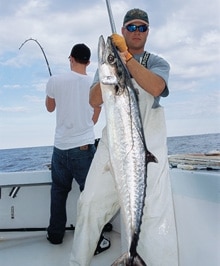
|| |—| || |SMOKER DETECTOR: If big kings are your target, drop the hook and start chumming. Photo: Ric Burnley| It was early fall, peak of the king mackerel tournament season off the southeastern North Carolina coast. Accompanied by my brother, Brant, and my father, Rube, we left the dock at the Ocean Isle Fishing Center at 6:30 a.m. with aspirations of returning to the scales with the winning kingfish.
We planned on fishing the Lighthouse Rocks just off the Cape Fear River channel, a spot notorious for attracting big fish and great numbers of fishermen. So as we approached, we were not at all surprised to see more than 120 boats fishing in a two-mile radius. Fortunately, we had a game plan to compensate. Vowing not to fall into the trap of slow-trolling live pogies, like 99 percent of the other teams, we chose to get on the hook and fish from a dead boat. Anchor fishing is a kingfish tactic that has been used for years, but for the most part it is a forgotten art. We hoped to make people remember.
By the end of the day, we went through some 40-plus rigs, released 60 kingfish at boatside and counted more than 80 strikes. Unfortunately, the hog of our dreams eluded us, but we did manage a respectable top-ten finish. Our largest fish of the day was just over 28 pounds-big enough to take eighth place and just five pounds lighter than the tournament winner. We all became believers in the anchor-and-heavy-chumming kingfish approach. And with further experimentation, I’ve learned that this technique will put smoker kings in the boat the whole year through.
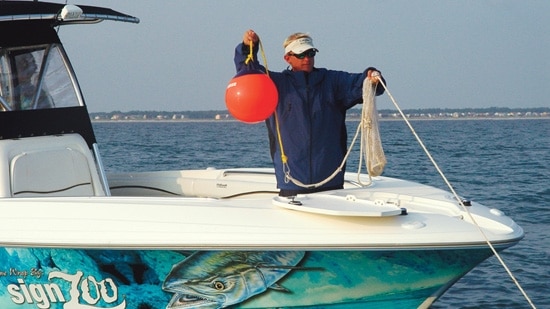
SET THE HOOK: A quick-release anchor system is key to McMullan’s top kingfish tactic.
Photo: Barrett McMullan
Finding the Strike Zone
There are several key factors to take into consideration when deciding exactly where to drop the hook.
First, you need to be in the general area where the kingfish are holding. In a broad sense, remember that kingfish prefer water temperatures in the 68- to 80-degree range. The fish move in- and offshore and up and down the water column to stay in that comfort zone.
In addition to comfortable water temperature, factors such as the presence of baitfish, water clarity and structure also play important roles. When picking your spots, take as many of these conditions as possible into consideration.
Once on the kingfish grounds it becomes necessary to narrow your target even further. Large kingfish inhabit many different types of structure and zones, including artificial reefs, wrecks, live-bottom areas, rocks, ledges, tidelines, inlets and pods of baitfish. However, keep in mind that not all conditions are ideally suited for anchor fishing. The anchor-and-chum tactic for kingfish should only be used if it is possible to concentrate the chum on a particular stationary area. Finding permanent structure, such as reefs and wrecks, within a body of favorable water temperature is critical. Tidelines or fast-moving pods of baitfish that don’t respond to chum should be avoided.
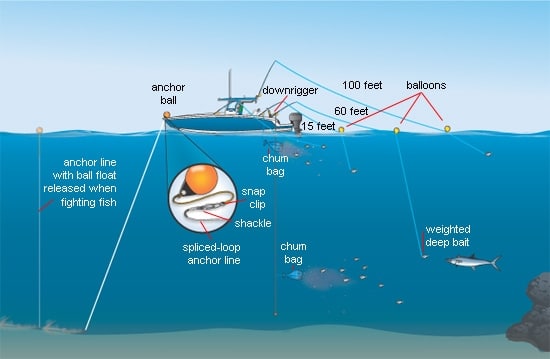
SUPER SPREAD: The McMullan anchor-and-chum spread is a model of simplicity. The breakaway anchor system allows anglers to get off the hook when fighting a fish.
Illustration: Pete Sucheski
Anchor Aweigh
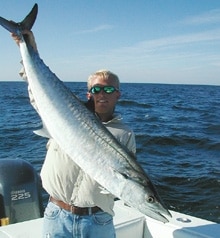
| |KING KONG: The author tails a chummed-up smoker. Photo: Barrett McMullan| Boat position should be based on the current flow and structure that you are planning to fish. For instance, to target kingfish that typically hang near a certain ledge, the correct boat position is exactly upcurrent by at least 50 yards and not more than 200 yards. The idea of anchoring ahead of the target is to allow the hard chumming to be directed over the particular piece of structure. This method will draw the fish from the ledge into the area of the baits. If the boat were anchored directly over the ledge, your chum line would likely miss the intended structure entirely and thus the fish as well.
Utilizing a breakaway anchor system more than makes up for your inherent lack of mobility. To accomplish this, make breaks in the anchor rope every 75 feet, or any length desired, and connect the breaks by splicing in loops connected by a stainless-steel shackle.
After dropping anchor, secure the anchor line to a cleat and confirm the set and location. Then pull the remaining anchor line from its locker until you reach one of the shackled breaks. At this point, unscrew the shackle and free the loop end of the line with the anchor at the other end. Next, attach a snapping clip to the loose end of a three-foot rope and snap the other end to an anchor ball. Clip the anchor ball to the looped end of the previously unshackled anchor line. Now, when that sizzling strike comes and there are boats fishing in close proximity you don’t have to worry; just take the anchor line off the cleat and toss the anchor ball and any remaining rope in the water. Now you’re free from the hook, which is attached to the large floating anchor ball, and are able to chase the fish-just as you would from a trolling boat.
Chum and They’ll Come
Once anchored, proper chumming becomes the key, and I begin even before I put out my first bait. The formula I have found to be most successful includes a drip bottle of threadfin herring oil and Capt. Mark’s (www.captmark.com) ground sardine chum. I prefer to use one of Capt. Mark’s 25-pound frozen blocks deployed in a mesh bag. I hang one bag off the back of the boat and attach another to my downrigger and send it to the bottom. I’ll occasionally wind the downrigger bag up and down through the water column to broadcast the chum at all depths of water. The objective is to attract smaller fish into the vicinity of the boat to feed on whatever chum you have available; a mossy-back kingfish won’t be far behind.
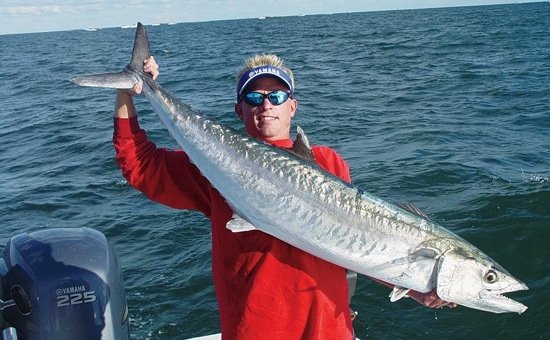
MACK-ZILLA: The biggest kingfish will come off wrecks and reefs in 68- to 80-degree water.
Photo: Barrett McMullan
Baring the Essentials
Reels with a high gear ratio-at least 6.2:1-that can hold at least 450 yards of 20-pound test are a must. I prefer the Shimano Speedmaster, Torium or Trinidad, Daiwa’s newly developed Saltiga and Penn’s 545GS. These fast-retrieve, high-volume reels give you a few more seconds to release from the anchor and chase down a fish before the spool is emptied.
Terminal tackle is nearly the same as what is used when slow-trolling. When at anchor, the bait has the ability to swim somewhat freely in any direction it pleases, creating a more natural presentation to interested gamefish. But this creates a problem when fishing from a still boat. Sometimes the bait will swim toward the boat in an attempt to escape a prowling kingfish and, as a result forms a loop of slack in the monofilament line. Now, when the kingfish strikes the bait it also gets the monofilament line in its mouth and before the rod even has time to bend, the fish, along with the terminal gear, is gone.
The answer is to increase the length of the wire leaders from less than 18 inches to at least three feet and as much as six feet. This change has made a drastic difference in my bite-to-catch ratio.
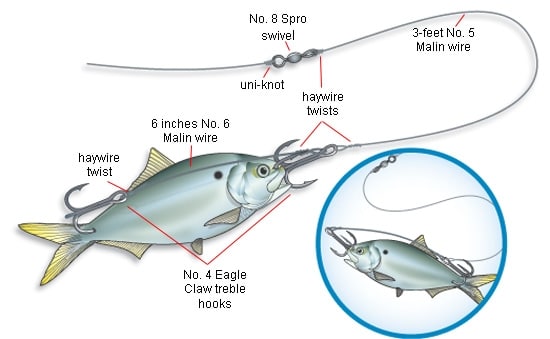
RIGHTEOUS RIG: McMullan’s standard pogy rig can also be fished in reverse (inset) so the baitfish swims away from the boat.
Illustration: Pete Sucheski
The Spread
My number-one spread consists of three live baits fished underneath balloons and either one or two free-lined live baits. The three lines fished with balloons are staggered behind the boat with one at 100 feet, another at 60 feet and the last one placed about 15 feet behind the motors. I use balloons to control the area where the baitfish swim. They act as bobbers and sails and keep the baits near the surface, allowing the wind to push the balloons to the desired position behind the boat. I tie a balloon about 15 feet above the leader. When the balloon is pulled under the surface it will pop, releasing the extra pressure on the line.
One additional twist that will sometimes get the action going is to use one of the balloon rigs as a deep bait. Use the same rig, but instead affix a two-ounce egg sinker to the line with a rubber band. Attach the balloon at any distance above the sinker. This allows a bait to be fished at any depth and any distance from the boat.
The bonus bait in the spread is the free-lined bait. Use the same live-bait rig but without the balloon. The live bait can be fished from the side, the front or the rear of the boat-the objective being not to tangle in the balloon rigs. After hooking the bait, simply put the reel in free-spool and give line to the bait as fast as it will take it. The bait has free rein on where it travels but many times it doesn’t get far before it gets hammered. This means the angler has to be ready to put the reel back in gear.
Targeting smoker kingfish from an anchored boat requires proper planning, equipment and practice.
It may have lost some of its popularity from the early days of king mackerel fishing, but it certainly has not lost its effectiveness.









